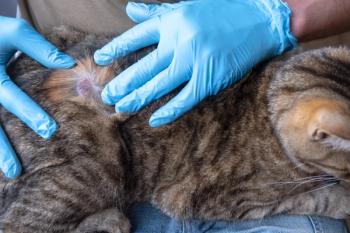
DVM Newsmakers' Summit: Supply in demand?
Editor's Note: DVM Newsmagazine asked six thought-leaders at CVC East in Baltimore to talk about five of the most pressing issues facing the veterinary profession. During the succeeding months, each of the issues introduced at the DVM Newsmaker's Summit will be presented for publication. This month, the panel takes on the supply of veterinarians and future professional opportunities. Dr. Lonnie King introduces the issue.
Editor's Note: DVM Newsmagazine asked six thought-leaders at CVC East in Baltimore to talk about five of the most pressing issues facing the veterinary profession. During the succeeding months, each of the issues introduced at the DVM Newsmaker's Summit will be presented for publication. This month, the panel takes on the supply of veterinarians and future professional opportunities. Dr. Lonnie King introduces the issue.
Figure 1 Veterinary medicine's opportunity horizon
Coming next month: A changing business model
About the panelists:
Dr. Bonnie Beaver, Texas A&M University, former president of the American Veterinary Medical Association.
Dr. Gary I. Block, Ocean State Veterinary Specialists in East Greenwich, R.I.; former president of the Rhode Island Veterinary Medical Association.
Dr. Joan Hendricks, dean of the University of Pennsylvania School of Veterinary Medicine.
Dr. Lonnie King, director of strategic innovation for the Centers for Disease Control and Prevention; former dean of the Michigan State University College of Veterinary Medicine.
Dr. David Lane, practitioner and consultant in Cardondale, Ill.
Moderator Kerry M. Richard, attorney with Tobin, O'Connor, Ewing and Richard in Washington, D.C.
Dr. Jack O. Walther, practitioner in Lamoille, Nev., and former AVMA president.
Dr. King: On the issue of supply and demand, I'm going to focus on public veterinary practice. We're going to have more time to talk about companion animal practice.
When we have commencement ceremonies at Michigan State, about 105 students stand up and pledge the veterinarian's oath. Unfortunately, that's probably the first time some have seen it. The veterinarian oath talks about the protection of animal health, relief of animal suffering, promotion of public health and the advancement of medical knowledge.
As veterinarians, everybody in this room has made that pledge. One of the things I want to talk about today is looking at the circles of what we've promised to do and the responsibility and obligation of veterinary medicine. It really has to do with supply and demand.
So, these circles (Figure 1) represent what we're obliged to do as protectors of public health, like managing our ecosystems, improving animal health and even food systems. Underpinning these four circles is biomedical and animal research. I will suggest to you that veterinary medicine is not meeting these challenges, opportunities and responsibilities in part because of supply and demand issues.
Dr. Lonnie King
Between 1 percent and 2 percent of the veterinary profession is actually involved in public health in terms of position description. I think we're all involved in public health. At a time when 75 percent of the new emerging infectious diseases in people actually come from or through animals, 80 percent of bioterrorist agents that we know of are zoonotic agents.
So we're at this time in our lives, at this remarkable 21st century melting pot, where last year 21 billion animals were produced worldwide for 6.5 billion people. By the year 2020 we anticipate a 50-percent increase in the need for animal proteins worldwide.
The issues of public health, the dimensions and factors that bring new and emerging diseases are actually in place and will accelerate. Veterinary medicine has a huge role to play.
In biomedical research right now, we are behind the pathologists and people involved in laboratory animal medicine and comparative medicine, in particular. Huge areas that are demanding veterinarians come to the forefront are not being filled. We're actually in an era we're moving from reductionism — looking at everything in molecular and nano technology — back to better understanding host and populations. Actually, a lot of NIH studies and RFP's are actually changing that. And veterinarian medicine is really the only group that understands population medicine. With global food and fiber systems, veterinarians are needed worldwide, and I would suggest that there's a huge need right now and pent-up demand for veterinarians to be involved in food systems. Managing our ecosystem, biodiversity, and a huge new area coming to the fore especially with wildlife, is how we manage that food safety and trade component. So, I would suggest the next five years is probably the time of the greatest opportunities in the history of veterinary medicine. It's also the era of the greatest challenges.
As we talk about supply and demand, we actually are going to take advantage of the most remarkable opportunities in our profession's history and those areas that we've talked about. And in each of those areas we are underperforming. We don't have enough veterinarians involved, and the future is an opportunity that I'm afraid will be missed. This is a defining moment in veterinarian medicine. Huge demands are surfacing now or will surface and there has been reluctance by the profession to be involved in producing the men and women to take on those new responsibilities. Right now less than 20 percent of veterinarians that are active today are involved in public practice, jobs in government in particular or in strictly food animal practice, and the 80 percent are actually involved in companion animal practice. Those are the things I want to put on the table right now.
Dr. Walther: I think that Dr. King has just brought up what I consider the No. 1 challenge and concern of our profession. We have a huge need for veterinarians in almost every discipline. We have an increasing number of veterinary positions that are being filled by lay personnel because graduate DVM's are not available. The frustrating part of it is that if you look at the potential for supplying more veterinarians from the veterinary schools in the United States, it doesn't exist.
We are not going to see huge increases from any school, much less every school. What's the answer? Maybe we are headed in the direction of the medical profession where an increasing number (now approaching one half of physicians), are foreign trained.
Dr. Jack Walther
Whether or not we like that and whether or not we would rather have them trained in the United States may not be an option. There are tremendous opportunities for foreign-trained veterinarians that come to the United States, if they can get licensed and find a job that is not comparable any place else in the world.
I'm not sure that there are any great answers, but it will be a dramatic change in the veterinary profession over the next five to 10 years.
Dr. Lane: First, we're talking about supply and demand here. The question is how much demand do we have? Unfortunately, the supply that's coming through the veterinary schools is the least diverse that you could possibly imagine. They just happen to be white females from suburban backgrounds who are going to treat one species area, companion animals. When you start having that kind of bullet approach to veterinary medicine, we aren't going to get people to go into food hygiene. I've never had a 7-year-old come up to me and ask about being a meat inspector. We need to diversify.
Unfortunately or fortunately, there is the work-force expansion act from Sen. Wayne Allard that would give us more money for buildings and supposedly more slots for veterinarians. Unfortunately, what is going to happen is we are just going to attract the same types into our veterinary schools. Where are we going to get people with diverse attitudes toward veterinary medicine? We don't know, but I would suggest that it could come from foreign graduates.
At the same time, we've erected all these barriers to foreign graduates. But we need to actually take some of these barriers down so we can get some of these people in because I would estimate they're all coming in from the large-animal side outside the United States. Many of them will want to go into foreign service, and I agree completely that we're not going to get this diversity through the veterinary schools. They're underfunded for the most part, and we need to seriously look overseas to solve this particular supply issue.
Dr. David Lane
Dr. King: That might be partially right. And I will tell you that students being admitted into veterinary colleges actually reflect the applicant pool. Until we do something with the applicant pool, the admission process really doesn't make a lot of difference to make subsequent changes. So the applicant pool are young students who see veterinary medicine out of the eyes of Animal Planet. They don't really see the opportunities or diverse possibilities for the veterinary profession, so that's one of the things we really need to work on.
There are 10,000 veterinary students in training. So, if you want to make a difference, then that group of 10,000 is a pretty good area to focus on. Three years ago we had two colleges of veterinary medicine that had former programs in public health.
Today, based on what we're doing in veterinary education, there are 17 colleges and schools of veterinary medicine that actually have relationships with schools of public health and dual programs in MPH.
Two months ago, Centers for Disease Control and Prevention had 300 veterinary students and faculty come to Atlanta on their own time to understand more about opportunities in public health. We had to cap attendance because we had too many students. So it gives you an idea of what can be done in terms of possibilities, if we could take 20 percent of each year's graduating class, which would be 2,500.
I would also suggest that we'll see a number of graduates from our veterinary schools go overseas. I guess if I were a young veterinarian, I would look at specializing and having a practice in Vienna or Sydney, Australia; and licensing in terms of international issues, that's exactly what's going to be happening so I'm not so sure that's going to be a supply and demand issue.
Dr. Hendricks: I really think in a lot of ways some of this is linked to the animal welfare discussion and when you look at animals that serve society. I think that even if we start with our incoming veterinary classes who are white, suburban and largely female and have not grown up in a situation where they saw animals working for a living, they are intensely interested. If we step up and have animal welfare science as an important part of the training, I think that will help in some ways. However, it is absolutely true that the people we have in veterinary school have come in with a certain idea of what veterinary medicine is. I think we need to start with pre-vet programs. We have a funny situation in Pennsylvania in that the veterinary school is in the southeast corner of the state inside a private university. The state's agricultural school is at Penn State. We have a coalition now working with Penn State to recruit students into their training programs so that those people come to our school thinking about business, food production and public service. Hopefully, we'll get them at that end. And even more importantly, we need to start educating at the pre-veterinary level and to middle-school and high-school students about veterinary opportunities. I talked with the leaders of a couple of really interesting schools in Philadelphia. One of the schools is an agricultural high school, and its students actually take two subways and a bus to get to this farm within the city limits. Some of the students work at meat science, and they have contests in butchering. These are young kids who have decided that this is the path they want to take. Some want to be veterinarians and a lot of them come in thinking about small animal, yet exit thinking about farm animal. I just want to bottle that and figure out how the transformation occurs. We're beginning to partner with them.
Dr. Joan Hendricks
The other school has very high-performing students. The head of the school said that its students don't want to be veterinarians, they all want to be MDs and they want to do biomedical research. I said they wanted to be veterinarians, they just don't know it yet. He said his students basically know whatever professions are on TV, so they all come in wanting to be forensic scientists. At dinner last night, we decided that we needed a CSI veterinarian to really make this work.
Finally, clearly finances of practice in the public sector are enormously important. Tons of students with all the goodwill in the world and even with an intense interest either in public health or food animal just plain can't afford it, and the lucrative part of practice relatively is treating individual animals. I'm veterinary Barbie myself, and I love it and I value the students who want to take care of cats and dogs. We really have to broaden everyone's sense of what they can do, and make it possible for them to do it.
Dr. Block: I couldn't agree more with everyone's comments, and I guess the million-dollar question for me is at what point can we nab these inspiring veterinarians to make a difference? I don't think it will happen once you're in veterinary school, with the inability to formally track into one of these public practice professions. It's really hard to get students interested at that point.
Dr. Gary I. Block
Dr. Beaver: Currently in the United States we have approximately 86,000 veterinarians. It means that any of the major football stadiums could be totally filled with veterinarians and still have space left over. It's a scary thought, when you consider that approximately 100,000 new attorneys are graduating every year. We're really talking about two different subjects. In one sense, we're talking about how do we get our current population of new graduates interested in areas that are slightly non-traditional, because those are also areas where opportunities exist.
There are a number of things that schools are doing to try to make those opportunities known to students. But a bigger issue, which I think Dr. King really addressed in some ways, is how do we increase the numbers of veterinarians in the United States if we have a shortage? We need to fill the current needs and fill the new opportunities as they develop. In part, foreign graduates will certainly help fill that role.
Dr. Bonnie Beaver
Physically, schools can only increase a certain size unless there is major new funding from the federal government, and I guess my question back to Dr. King would be: In 1998, we had the KPMG study that said we actually have a surplus of veterinarians, so how did we miss it? How did we not identify that this need was really going to be there and start at that time looking for ways to increase numbers?
Dr. King: I went back and read that KPMG study, and its observations were stated in purely economic terms. We don't live in purely economic terms. They also recommended that we need more veterinarians because the profession was operating under a poor business model. It also said that there are remarkable opportunities that are being missed. And one of the issues is that we didn't lack opportunities but we may lack the skills necessary to take advantage of the opportunities, and that's a whole different area.
I would also say that I see a number of students, young veterinarians two or three years out, actually come back to the schools because they are not that satisfied with private practice. They are looking at other possibilities for career enhancement. It represents a fairly sizable cohort that we can start to redirect in some these areas of public practice and in areas that might be underserved. I'm also concerned over the statistics in food animal practices that within five years, 50 percent of young veterinarians going into that segment actually leave. So it's also about retention.
This is a big issue of leadership for the profession. We don't want to create a heritage of lost opportunity, and I think if we can get onboard with these obligations as a profession, I think that's what really needs to be done. We need to take advantage of these really remarkable opportunities.
Question from the audience: Are we turning into a part-time profession?
Dr. King: This is a major issue in the private sector because 25 percent of all veterinarians are now in part-time practice, and the number is growing. It's mostly a gender issue, because only 10 percent of men are practicing part-time, which is almost all attributed to semi-retirement. That will change over time naturally.
The reality is we will need a lot more veterinarians. There is a good thing about part-time veterinary medicine in that it's easier to patch in people if you can't afford a full-time person.
I work with one practice that has three or four ladies, and they're all working part time. None of them, including the owner, will work anything but part time. It poses tremendous operational and logistical issues to run a practice, and this is our future.
Newsletter
From exam room tips to practice management insights, get trusted veterinary news delivered straight to your inbox—subscribe to dvm360.




